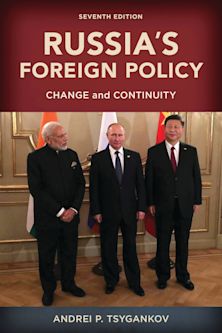- Home
- ACADEMIC
- Politics & International Relations
- Foreign Policy and Diplomacy
- Conflict Prevention from Rhetoric to Reality
Conflict Prevention from Rhetoric to Reality
Organizations and Institutions, Volume 2
David Carment (Anthology Editor) , Albrecht Schnabel (Anthology Editor) , Pamela R. Aall (Contributor) , Greg Austin (Contributor) , Monica Blagescu (Contributor) , Derek Boothby (Contributor) , Ashley Campbell (Contributor) , George D'Angelo (Contributor) , Anton Ivanov (Contributor) , Béatrice Labonne (Contributor) , David Nyheim (Contributor) , André Oullette (Contributor) , Connie Peck (Contributor) , Dianna Rienstra (Contributor) , Barnett R. Rubin (Contributor) , Tatjana Sikoska (Contributor) , Juliet Solomon (Contributor) , Gerald Steinberg (Contributor) , Luc van de Goor (Contributor) , Suzanne Verstegen (Contributor)
Conflict Prevention from Rhetoric to Reality
Organizations and Institutions, Volume 2
David Carment (Anthology Editor) , Albrecht Schnabel (Anthology Editor) , Pamela R. Aall (Contributor) , Greg Austin (Contributor) , Monica Blagescu (Contributor) , Derek Boothby (Contributor) , Ashley Campbell (Contributor) , George D'Angelo (Contributor) , Anton Ivanov (Contributor) , Béatrice Labonne (Contributor) , David Nyheim (Contributor) , André Oullette (Contributor) , Connie Peck (Contributor) , Dianna Rienstra (Contributor) , Barnett R. Rubin (Contributor) , Tatjana Sikoska (Contributor) , Juliet Solomon (Contributor) , Gerald Steinberg (Contributor) , Luc van de Goor (Contributor) , Suzanne Verstegen (Contributor)
This product is usually dispatched within 2-4 weeks
- Delivery and returns info
-
Flat rate of $10.00 for shipping anywhere in Australia
You must sign in to add this item to your wishlist. Please sign in or create an account
Description
There is a widening range of organizations that are being called upon to do conflict prevention. These actors range from the corporate sector and NGOs to regional and multilateral economic and political organizations, with diverse mandates, leadership, funding, and operational activities. Conflict Prevention from Rhetoric to Reality, Volume 2: Opportunities and Innovations offers a critical evaluation of existing and emerging approaches to applied conflict prevention. An international team of practitioners and researchers with rich theoretical and field experience examine the analytical requirements to understand the causes of conflict and link these causes to a range of response options by a variety of relevant actors. They also discuss the newest frontiers of conflict prevention, including the threat of terrorism and the role of the private sector. While development practitioners, the corporate sector, foreign policy makers, and NGOs are coming to conflict prevention from different directions, they nevertheless reflect common objectives, and need to be able to speak each other's language. The volume highlights innovative approaches to allow individuals within these organizations to understand how they can best use the array of political, economic, social and developmental instruments available to them to be better analysts and to provide for more effective responses.
Table of Contents
Chapter 2 Into the Mainstream: Applied Conflict Prevention
Part 3 Analytical Requirements
Chapter 3 Natural Resource Endowment and Conflicts in Developing Countries: From Causes to Possible Solutions
Chapter 4 Sources of Violent Conflict
Chapter 4 Introducing Gender in Conflict and Conflict Prevention: Conceptual and Policy Implications
Chapter 7 Anticipating State Failure
Chapter 7 "Mainstreaming" Conflict Prevention Policies of Third-party Actors: Building an In-house Capacity for Preventive Action
Chapter 8 Generating the Means to an End: Political Will and Integrated Responses to Early Warning
Chapter 8 Human Security and Conflict Prevention
Part 9 Response Strategies and Capacity Building
Chapter 9 Non-governmental Organizations and Conflict Prevention: Roles, Capabilities, Limitations
Chapter 11 Training as a Means to Build Capacity in Conflict Prevention: The UNITAR Approach
Chapter 12 Building Capacity within the United Nations: Cooperation of the Prevention of Violent Conflicts
Chapter 13 Conflict Prevention through Peace Education: A Debate
Part 16 The Frontiers of Applied Conflict Prevention
Chapter 17 The Centrality of Confidence Building Measures: Lessons from the Middle East
Chapter 18 Preventing Terrorism? Direct Measures First-Intrusive, Nomrative, and Personal
Chapter 19 Conflict Prevention and Financial Capacity Building
Chapter 20 Assessing the Corporate Sector's Role in Conflict Prevention
Chapter 21 The Private Sector and Conflict Prevention Mainstreaming
Product details
| Published | 02 Jul 2004 |
|---|---|
| Format | Paperback |
| Edition | 1st |
| Extent | 458 |
| ISBN | 9780739107393 |
| Imprint | Lexington Books |
| Dimensions | 225 x 238 mm |
| Publisher | Bloomsbury Publishing |
About the contributors
Reviews
-
These two volumes form an encyclopedic study of the means of conflict prevention The first volume examines agents and institutions, the second causes and capacities. The choice of chapters to encompass the components of the subject is careful and comprehensive, and there is much breadth and wisdom in the chapters themselves. The volumes deserve a wide and bifocal audience. For analysts, the two volumes push back the frontiers into new aspects to study; for practitioners, they show that the challenge is in applying what we know aplenty, not in hiding behind claims of ignorance.
I. William Zartman, The Paul H. Nitze School of Advanced International Studies, Johns Hopkins University
-
It is always a pleasure to come across volumes with the breadth and scope as the ones edited so perceptively by David Carment and Albrecht Schnabel. Their gumption illuminates the patterns of mainstreaming conflict prevention in the post-Cold War period. In this respect, these tomes are not simply a reassessment of extant analytical frameworks, but an inspiring mapping of politics and policy of conflict prevention. Thence, the two parts of Conflict Prevention are a lasting testimony of the encyclopedic endeavor to chart the gist of different conflict prevention approaches, while presenting a cornucopia of insight and best-practice.
Panorama
-
The scholarship is first-rate, thorough, and comprehensive. This work will be a significant contribution to the study, training and practice of conflict prevention.... I regard the theoretical discussion in the second volume among its greatest strengths' overall the original evidence, comprehensiveness, and integrative nature of the work are its best features.
Franke Wilmer, Director and Professor, Political Science, Montana State University, Bozeman, , Director and Professor, Political Science, Montana State University, Bozeman



































